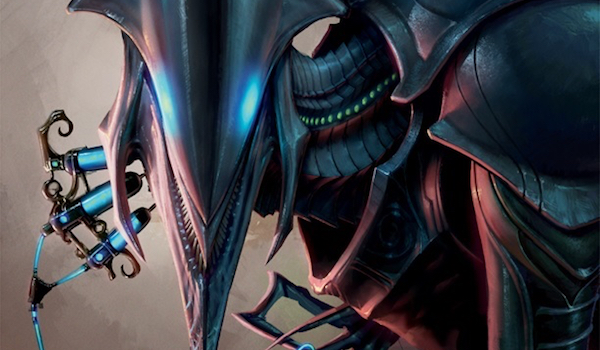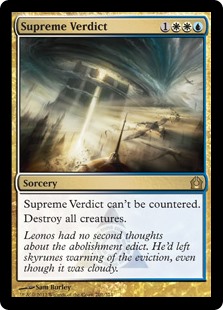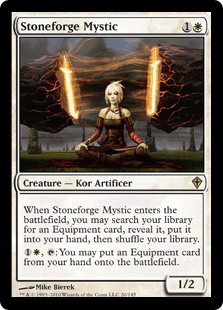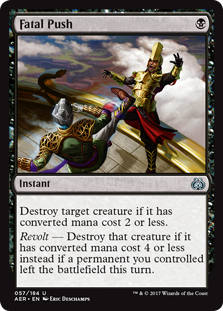Are you a Quiet Speculation member?
If not, now is a perfect time to join up! Our powerful tools, breaking-news analysis, and exclusive Discord channel will make sure you stay up to date and ahead of the curve.
The "Death's Shadow is the best deck" narrative we saw emerge in force around Grand Prix Vancouver has now split, with some claiming Eldrazi Tron is in fact the best deck. I tend to agree with the former, and will softly make a case for that inclination in this article. Regardless, we can surely agree that both decks are very powerful. Their influence in Modern is another, and in my eyes more interesting, story.

It's possible to read the metagame as David did earlier this week and point to Eldrazi Tron as the catalyst for Modern's reshaping. But it seems to me that Grixis Shadow is truly the best deck, and the one at the root of the shifts—ban Eldrazi Temple, and I bet Grixis Shadow enjoys a similar amount of success if not more, and the metagame trends established in the past few weeks intensify. Today, we'll look at the warping effects Shadow has had on the Modern metagame to assess whether the deck does more harm than good.
The Good
Providing a Skill-Testing, Interactive Option
Perhaps most obviously, Shadow being the format's best deck is great news for the Twin apologists who have been clamoring for such a deck. It's a Snapcaster Mage deck, which fulfills a certain niche by itself. It also doesn't suffer from the BGx problem of awful ramp matchups. The deck's skill ceiling is miles-high, and Shadow plays very fair Magic very effectively. That's why, despite the deck's sustained success, players calling for a Shadow ban are in the minority.
Enabling Control
 Control decks in Modern have always struggled with the format's diversity. They found it difficult to at once attack linear combo decks, fast aggro decks, and attrition-style BGx decks at once. Control should have a naturally favorable BGx matchup, for example, but the deck was often stretched thin enough that the matchup was winnable for Tarmogoyf—in fact, BGx often preferred to pair with control decks than with Tron.
Control decks in Modern have always struggled with the format's diversity. They found it difficult to at once attack linear combo decks, fast aggro decks, and attrition-style BGx decks at once. Control should have a naturally favorable BGx matchup, for example, but the deck was often stretched thin enough that the matchup was winnable for Tarmogoyf—in fact, BGx often preferred to pair with control decks than with Tron.
Now that Grixis Shadow is the reigning midrange deck in Modern, life gets much easier for reactive control decks. At level zero, Shadow is easier to beat than other midrange decks. It plays fewer threats and is overall much more fragile, trading in the robustness of GBx for the consistency and efficiency necessary to defeat big mana.
Going deeper, ramp's switch from Gx Tron to Eldrazi Tron, itself imposed by Shadow's presence, also throws a bone to control decks. Matter Reshaper and Reality Smasher are a lot easier to beat than Karn Liberated and World Breaker; after all, they die to cards that are great against the format's other top deck, Path to Exile and Surpeme Verdict.
Opening the Floodgates to Innovation
A year ago, Bolt was everywhere, and Mirran Crusader was a poster-child for unplayable Modern creatures. But times have changed. Shadow is focused and streamlined enough that savvy deckbuilders can find ways to exploit its taut design, such as running a three-mana, pro-black creature.
The general decline of Bolt has also fueled some innovation. Bolt is miserable against Shadow decks, and the Shadow decks don't have to play it to do well—in fact, they're often better off without it to gain an edge in the mirror. All that one-upmanship creates yet another opportunity for brewers to break through, though, and it's no coincidence we've seen Hatebears-style fish decks perform admirably at multiple high-profile events now, putting two players into the GP Las Vegas Top 8 and taking down the SCG Season 1 Invitational.
Given Modern's vast card pool, we're sure to see some more clever maneuvers to beat Shadow in the near future. But it's also important to remember that the innovation won't last forever. Once the dust settles, and Shadow gets more comfortable with its seat in the usurped BGx throne, Modern will stagnate again; the strategies that beat Shadow will have been discovered, and Shadow will either have adjusted to beat them or resolved to dodge them. Hopefully, more of those strategies pop up before that happens, and are competent enough to become Modern fixtures.
Adding Color Diversity

Wizards has recently expressed a desire to improve Modern's color diversity. At the time of the announcement, everyone and their Goblin Guide knew the company was referring to white and blue's relative weaknesses in, and absences from, the metagame. The statement even inspired me to write an article in favor of a Stoneforge Mystic unban.
Jund Shadow has since evolved into Grixis Shadow, a blue deck itself, which in turn buffed Path to Exile decks like UW Control and Hatebears. While I still don't think Stoneforge would be too powerful for Modern, the goal of that possible unban—to improve color diversity—has already been achieved by Grixis Shadow.
The Bad
Homogenizing Midrange
To be fair, pre-Shadow "discovery" and post-Twin ban, Modern's midrange decks were almost exclusively of the BGx Rock variety. That's a solid year of Goyf dominance. One might conclude, then, that Shadow isn't homogenizing midrange decks; midrange decks were already homogenized.
Why, then, does Shadow make up such a large percentage of all midrange shares? It currently occupies shares comparable to those of Jund and Abzan in the post-Twin period, and both decks are still Modern-legal in their entirety. So, as David asked, where's the Jund?
I think the answer is a bit more complicated than "Jund loses to Eldrazi Tron." In my experience, in fact, BGx does better against Eldrazi Tron than it does against Gx Tron. It's true that Shadow tends to defeat big-mana decks where Rock has failed, with Eldrazi Tron posing the most serious hurdles for Shadow (and still struggling in the face of an experienced pilot).  But here, too, the refined statement, "Shadow beats big mana," doesn't account for other factors in BGx's decline—such as Dredge's comeback (fueled mostly by players realizing the deck is actually still great) and the rise of control decks (which are incentivized to play heavy removal suites in this metagame).
But here, too, the refined statement, "Shadow beats big mana," doesn't account for other factors in BGx's decline—such as Dredge's comeback (fueled mostly by players realizing the deck is actually still great) and the rise of control decks (which are incentivized to play heavy removal suites in this metagame).
It doesn't just stop at metagame positioning. Grixis Shadow (and Jund Shadow, for that matter) is simply a far better Modern deck than BGx Rock. In "Death's Shadow: Analysis, Implications, Potential," I ran Shadow decks through the three golden parameters of Modern viability: proactivity, interactivity, and consistency. My theory states that successful Modern decks must score reasonably on one or two of these metrics while specializing in another, or otherwise totally nail one component. Shadow decks score highly on all three, though, which is something we haven't seen in Modern outside of decks Wizards has banned. That's not necessarily to say that I think Shadow will get a ban, but it does provide some quantifiable measures of the deck's immense power, especially relative to that of other Modern decks.
Gutting Aggro-Combo
Linear combo has never dominated Modern, if mainly for the reason that Wizards is forced to ban them—in order to succeed in a given metagame, linear combo must win more quickly than the format's aggro-combo decks, which in turn must win before turn four to be viable in Modern. Fast linear combo decks then violate the Turn-Four Rule and rarely last. Still, somebody has to police Tron and company. That's where aggro-combo comes in.
Aggro-combo frequently wins before turn four when unmolested, but the nature of its win conditions (Blighted Agent, Kiln Fiend, Signal Pest, etc.) opens the door for opponents to interact with them. As a result, these decks rarely become oppressive, and create a healthy (on paper, at least) rock-paper-scissors effect where midrange beats aggro-combo, aggro-combo beats ramp, and ramp beats midrange.
Grixis Shadow's rise to dominance has ravaged the once-diverse aggro-combo lineup. Three episodes led to its dismantling:
- The banning of Gitaxian Probe. In hindsight, it's probably for the best that Grixis Shadow never got to play with this card. But without Probe, Infect can't run as many copies of Become Immense and loses both the information necessary for such an all-in strategy, and velocity helpful for streamlined decks. Many other aggro-combo decks, such as UR Kiln Fiend and Jeskai Prowess, also went extinct with the Probe ban.
 The printing of Fatal Push. Perhaps the most impactful card to ever be printed in Modern (and not subsequently banned), Push radically reinvented the format landscape, pummeling the stock of Tarmogoyfs and Blighted Agents alike. Aggro-combo decks have a miserable time closing out games against decks with Fatal Push, and those decks happen to make up a huge portion of the metagame. It doesn't help that Push is great against the Shadow decks as well, so players suiting up to beat Shadow are likely to sleeve up a card that incidentally crushes aggro-combo.
The printing of Fatal Push. Perhaps the most impactful card to ever be printed in Modern (and not subsequently banned), Push radically reinvented the format landscape, pummeling the stock of Tarmogoyfs and Blighted Agents alike. Aggro-combo decks have a miserable time closing out games against decks with Fatal Push, and those decks happen to make up a huge portion of the metagame. It doesn't help that Push is great against the Shadow decks as well, so players suiting up to beat Shadow are likely to sleeve up a card that incidentally crushes aggro-combo.- We don't need 'em. The least-talked-about reason for aggro-combo leaving the building? Its functions are being fulfilled by the Shadow decks. Thoughtseize into Shadow into Denial is plenty good against big mana and linear combo, so more fragile aggro-combo decks like Infect become silly to play—they retain their good combo matchups, but lose to Shadow and to decks trying to beat Shadow. Shadow borrows those good matchups and... well, and is Shadow.
On the surface, it might be tempting to cheer at the fall of aggro-combo. The archetype was everywhere after Twin got banned, and drew ire from players concerned Modern had become too linear. Indeed, since Shadow's ascent, Modern is significantly more interactive (in no small part thanks to the most popular deck being one of the most interactive the format has ever seen).
Aggro-combo devolving into only Burn, Affinity, and Dredge lowers format diversity. Where there were once plenty of aggro-combo options to choose from, only two remain. The third point on our above list concerns me the most. Shadow now controls not just the vast majority of the midrange shares but a good deal of the aggro-combo shares, simply by virtue of fulfilling the latter's roles more effectively.
The (Supreme) Verdict
Ultimately, whether the pros outweigh the cons depends on subjective perceptions of format health. So what do you think? Is Shadow friend to Modern, or foe? Let me know in the comments.





I vote friend, though with quick disclaimers that I did not even learn about modern until right after the Twin ban.
The deck is a highly-interactive, complex deck that rewards skill and knowledge with each game. That’s good. It has weaknesses due to its manabase, low threat count and reliance on 1 cmc spells but doesn’t automatically roll over to any hate cards. It has some bad matchups, so far I’ve noticed burn, hatebears and elves (probably 50/50 on that last one or slight elves advantage). As far as I know, it literally has no way to violate the turn 4 rule. The deck is, at worst, “fair” due to the low-costed threats.
Hell, none made top 8 at Vegas. Most people were expecting at least 3 copies. Yes, it was well-represented in the top 32, but clearly it hasn’t just taken over. The Eldrazi Winter set the standard for a tier zero deck, and I think Infect/Dredge pre probe banning is a better example of “cheap” decks being at the top. Something has to be the best, and in this case I think some players are just mad that it isn’t Jund.
That’s the part that I keep laughing about. I’m on other sites, other forums, and players seem to be more upset that the format has changed significantly in the last year than anything else.
Meanwhile, I’ll keep playing storm until it wins a GP and WOTC bans Grapeshot…
My biggest problem with shadow is not the deck itself, but rather that it has enabled draw-go strategies, which are the only strategy that the various prison decks I use cannot beat.
Not sure if this is a serious comment or not, but I’ll bite.
In that case, your goals for the format are not at all in line with those of Wizards (or of most of the community as I understand it). Wizards prioritizes diversity when it comes to Modern; it would be a nightmare if they ran it according to perceptions of “fun” or pet deck biases. If they loved supporting prison that would be great for you, but what if they loved supporting draw-go, instead? Someone would always be left out with that style of format management. Prioritizing diversity, which is objective and measurable, helps include as many types of players as possible—including you! FWIW, prison elements happen to be quite good against Shadow.
Definitely a friend of Modern. Being a UWx Control player, Shadow is appreciated.
Has anyone out there done any testing of Shadow decks without Street Wraith? Does the completely fold without it, or is it still viable? Perhaps Wizards could curb the deck a bit if it deemed necessary by banning Street Wraith. I don’t believe the deck needs a ban (currently) but perhaps the powers that be could scale things back by giving Wraith the axe.
I know that others have said that Wraiths essentially make the deck a 56 card deck, do you think there’s something to this argument?
Ryan Overturf had some brief success with a list that ran Delver over Wraith:
https://www.mtggoldfish.com/deck/581699#paper
He got this finish just before Jund Shadow became Grixis. To my knowledge nobody else has tested it. Wraith still has a cost to cycle so I don’t buy the “56 cards” thing. It depends how you’re looking at things, though. I’d argue the velocity and cantrip effect provided by Wraith, not even to mention the life loss, make the card better in Shadow than actually playing 56 cards would be. Other benefits include retrieval with KC and turning Visions into Preordain.
I still believe it’s too early to take any steps against GDS, but it seems that if things do reach a tipping point a good hard look at Street Wraith would be in order. I know a ban is never something Wizards takes lightly, and a Wraith ban would certainly have reverberations (i.e. Living End).
Thanks for getting back to us on this.
Reverberations are not something Wizards seems too bothered with. If they want to target a deck or card, they will take action regardless of ripple effects (like Probe for Delver or Eye for Tron).
Eye also hitting Tron was not an unexpected reverberation, that was viewed as a benefit. Tron had a huge amount of inevitability bc eventually they would bring out Eye and just start fetching up threats each round. The main target was clearly Eldrazi, but I think the fact that it slowed Tron down a bit was viewed as a positive as it was everywhere at the time as well.
Not entirely true. Wizards mentioned in the ban announcement that the fact that Eye hit Tron was unfortunate. And Probe wasn’t even a core Delver card, many players didn’t use it at all.
Great article Jordan. I love the current Modern, though I miss aggro-combo decks for sure, which have indeed decreased greatly in diversity and metagame share. However, since the Shadow takeover, I’d argue that overall, meta diversity has increased. Archetype diversity has remained about the same, since control has risen while aggro-combo has fallen. So in the end, this meta is the healthiest we’ve had in a while.
Agree ^_^ This Modern rocks!!
Every time someone cries about Splinter Twin being banned and making jokes about format diversity in the immediate wake, I have to just wonder if they are not paying attention to where things stand now.
Speaking toward the question of what deck is the top in the format currently, it’s really interesting to look at where things stand from recent events. I’ve been trying to group events in roughly month long categories recently and my first grouping was from 5/27-7/2. This included the Kobe T32, Copenhagen T36, SCG Charlotte combined meta (T32 Open, T16 Classic), GP Vegas T32, Invitational 7-1 Modern Decks, plus the combined meta of the Open and Classic.
In this Top Tables Metagame, Grixis Death Shadow is absurdly the Tier 0 deck with 31 finishes. Interestingly, Control decks (here a meta-archetype consisting of Jeskai Control, W/R Prison, Lantern Control, U/W Control, Esper Control, Death & Taxes & Control, 4C Control, Skred Red, Madcap Moon) also had a total of 33 finishes in that same time period. Close behind that were CoCo decks w/25 finishes (largely on the back of Devoted Company’s 16 finishes), B/G/x decks w/18, Affinity w/19, as well as Eldrazi Tron and Burn, both with 18.
Shifting into the next period (I looked at the GPs and SCG events for the rest of the year and grouped dates that made the most sense), we have the overlap from the last group of GP Vegas and the Invitational, plus the Modern Classic from Cincinnati.
Affinity actually has 17 finishes in this period, with Control and Grixis Death Shadow tied at 16. Eldrazi Tron has 10 and B/G/x decks have 9. Burn, CoCo, Jeskai Control all have 7; Merfolk and Non-Eldrazi Tron have 6 and Bant Eldrazi has 5.
The format is definitely reflecting that people left their artifact hate at home for awhile now and Death Shadow has certainly been targeted. This weekend’s Atlanta Team Open will be the end of this group of dates, and I’m very curious to see how the format continues to shift.
For anyone curious, here is how I’m grouping events for the rest of the year:
Meta: 7/22-8/13
7/22 SCG Atlanta (Team Constructed)
8/5 SCG Syracuse (Modern)
8/12 SCG Richmond | GP Birmingham | Sao Paulo (Modern)
Meta: 9/16-10/22
9/16 SCG Louisville (Modern)
10/5 Worlds (??)
10/14 SCG Charlotte (Modern)
10/21 SCG Cincinnati (Modern)
Meta: 10/14-11/19
10/14 SCG Charlotte (Modern)
10/21 SCG Cincinnati (Modern)
11/4 SCG Regionals (Modern)
11/18 SCG Baltimore (Team Constructed)
Meta: 11/4-12/9
11/4 SCG Regionals
11/18 SCG Baltimore (Team Constructed)
12/1 SCG Invitational (Modern/Standard)
12/1 World Magic Cup (Team Unified Modern)
12/8 GP OKC (Modern)
12/8 GP Madrid (Team Unified Modern)
It seems like your definition of “Tier 0” differs wildly from Nexus’s: https://quietspeculation.com/modern-metagame-breakdown-2516-362016/
In any case, I’m also excited to see how the format shapes up
In the very recent past, over a couple of big tournament weekends, Death Shadow decks had been exactly half of all results. It’s actually been trending steadily downward since then, but I was using Tier 0 just to signify what seemed to be the clear best deck at the moment. If we consider that tier to be “if you don’t have game against this deck, why are you even playing this weekend?”, then that is also quite reasonable.
Either way, it’s a lot of data and I have fun analyzing it all
When words have a certain established meaning, I’m wary about using them to mean something else. Tier 0 decks boast percentages that outdo those of all Tier 1 decks combined. I see what you mean now though, and I’m pretty anal about word choice, so don’t mind me if you prefer your own definitions!